Development and Characterization of SBA-15 Imprinted Polymers for Spiramycin Analysis
Abstract
:1. Introduction
2. Materials and Methods
2.1. Reagents and Materials
2.2. Synthesis of SBA-15 and SBA-15@MIP-SPI
2.2.1. Synthesis of SBA-15
2.2.2. Preparation of SBA-15@MIP-SPI
2.3. Characterization of the Synthesized Material
2.4. Solid-Phase Extraction Conditions
2.5. Chromatographic Conditions
2.6. Sample Preparation
3. Results and Discussion
3.1. Characterization of the SBA-15 and SBA-15@MIP-SPI
3.1.1. Textural Characterization of Materials Synthesized through Nitrogen Physisorption
3.1.2. FT-IR Spectra
3.1.3. Morphological Study by SEM
3.2. Assessment of the SBA-15@MIP-SPI as SPE Sorbent
3.3. Selectivity of SBA-15@MIP-SPI vs. SBA-15@NIP
3.4. Performance of the Method
3.5. Application of SBA-15@MIP-SPI in SPI-Spiked Milk Samples
3.6. Comparison with Other Methodologies
4. Conclusions
Author Contributions
Funding
Data Availability Statement
Conflicts of Interest
References
- Chabbert, Y.A. Early studies on in-vitro and experimental activity of spiramycin: A review. J. Antimicrob. Chemother. 1988, 22, 1–11. [Google Scholar] [CrossRef] [PubMed]
- Kanfer, I.; Skinner, M.F.; Walker, R.B. Analysis of macrolide antibiotics. J. Chromatogr. A 1998, 812, 255–286. [Google Scholar] [CrossRef] [PubMed]
- Wang, J.; Leung, D. Determination of spiramycin and neospiramycin antibiotic residues in raw milk using LC/ESI-MS/MS and solid-phase extraction. J. Sep. Sci. 2009, 32, 681–688. [Google Scholar] [CrossRef] [PubMed]
- Elazab, S.T.; Elshater, N.S.; Hashem, Y.H.; Al-Atfeehy, N.M.; Lee, E.B.; Park, S.C.; Hsu, W.H. Pharmacokinetic/pharmacodynamic modeling of spiramycin against mycoplasma synoviae in chickens. Pathogens 2021, 10, 1238. [Google Scholar] [CrossRef] [PubMed]
- Henchion, M.; Moloney, A.P.; Hyland, J.; Zimmermann, J.; McCarthy, S. Review: Trends for meat, milk and egg consumption for the next decades and the role played by livestock systems in the global production of proteins. Animal 2021, 15, 100287. [Google Scholar] [CrossRef] [PubMed]
- Commission Regulation (EU) No 37/2010 of 22 December 2009 on Pharmacologically Active Substances and Their Classification Regarding in Foodstuffs of Animal Origin Maximum Residue Limits in Foodstuffs of Animal Origin. Off. J. Eur. Union. Available online: https://health.ec.europa.eu/system/files/2016-11/reg_2010_37_en_0.pdf (accessed on 5 September 2023).
- Hu, C.; Zhang, Y.; Zhou, Y.; Liu, Z.; Meng, Q.; Feng, X. song A review of pretreatment and analysis of macrolides in food (Update Since 2010). J. Chromatogr. A 2020, 1634, 461662. [Google Scholar] [CrossRef]
- Khatibi, S.A.; Hamidi, S.; Siahi-Shadbad, M.R. Current trends in sample preparation by solid-phase extraction techniques for the determination of antibiotic residues in foodstuffs: A review. Crit. Rev. Food Sci. Nutr. 2021, 61, 3361–3382. [Google Scholar] [CrossRef] [PubMed]
- Chen, D.; Yu, J.; Tao, Y.; Pan, Y.; Xie, S.; Huang, L.; Peng, D.; Wang, X.; Wang, Y.; Liu, Z.; et al. Qualitative screening of veterinary anti-microbial agents in tissues, milk, and eggs of food-producing animals using liquid chromatography coupled with tandem mass spectrometry. J. Chromatogr. B Anal. Technol. Biomed. Life Sci. 2016, 1017–1018, 82–88. [Google Scholar] [CrossRef]
- Bohm, D.A.; Stachel, C.S.; Gowik, P. Multi-method for the determination of antibiotics of different substance groups in milk and validation in accordance with Commission Decision 2002/657/EC. J. Chromatogr. A 2009, 1216, 8217–8223. [Google Scholar] [CrossRef]
- Wang, J.; Leung, D. Analyses of macrolide antibiotic residues in eggs, raw milk, and honey using both ultra-performance liquid chromatography/quadrupole time-of-flight mass spectrometry and high-performance liquid chromatography/tandem mass spectrometry. Rapid Commun. Mass Spectrom. 2007, 21, 3213–3222. [Google Scholar] [CrossRef] [PubMed]
- Wang, J.; Leung, D.; Butterworth, F. Determination of Five Macrolide Antibiotic Residues in Eggs Using Liquid Chromatography/Electrospray Ionization Tandem Mass Spectrometry. J. Agric. Food Chem. 2005, 53, 1857–1865. [Google Scholar] [CrossRef] [PubMed]
- Garrido Frenich, A.; del Aguilera-Luiz, M.M.; Martínez Vidal, J.L.; Romero-González, R. Comparison of several extraction techniques for multiclass analysis of veterinary drugs in eggs using ultra-high pressure liquid chromatography-tandem mass spectrometry. Anal. Chim. Acta 2010, 661, 150–160. [Google Scholar] [CrossRef] [PubMed]
- González-Gómez, L.; Morante-Zarcero, S.; Pérez-Quintanilla, D.; González, G.P.; Garcinuño, R.M.; Hernando, P.F.; Sierra, I. Fibreglass membrane chemically modified with amino-functionalised SBA-15 and its application in solid-phase extraction to determine macrolide antibiotics in eggs. Microchem. J. 2024, 205, 111232–111245. [Google Scholar] [CrossRef]
- Leal, C.; Codony, R.; Compañó, R.; Granados, M.; Prat, M.D. Determination of macrolide antibiotics by liquid chromatography. J. Chromatogr. A 2001, 910, 285–290. [Google Scholar] [CrossRef]
- López-Lorente, Á.I.; Pena-Pereira, F.; Pedersen-Bjergaard, S.; Zuin, V.G.; Ozkan, S.A.; Psillakis, E. The ten principles of green sample preparation. TrAC Trends Anal. Chem. 2022, 148, 116530. [Google Scholar] [CrossRef]
- Sierra, I.; Morante-Zarcero, S. New Advances in Food Sample Preparation with Nanomaterials for Organic Contaminants Analysis by Liquid Chromatography. In Nanomaterials in Chromatography; Elsevier: Amsterdam, The Netherlands, 2018; pp. 118–154. ISBN 9780128127926. [Google Scholar]
- Vasapollo, G.; Del Sole, R.; Mergola, L.; Lazzoi, M.R.; Scardino, A.; Scorrano, S.; Mele, G. Molecularly imprinted polymers: Present and future prospective. Int. J. Mol. Sci. 2011, 12, 5908–5945. [Google Scholar] [CrossRef]
- Turiel, E.; Martín-Esteban, A. Molecularly imprinted polymers for sample preparation: A review. Anal. Chim. Acta 2010, 668, 87–99. [Google Scholar] [CrossRef]
- He, H.; Gu, X.; Shi, L.; Hong, J.; Zhang, H.; Gao, Y.; Du, S.; Chen, L. Molecularly imprinted polymers based on SBA-15 for selective solid-phase extraction of baicalein from plasma samples. Anal. Bioanal. Chem. 2015, 407, 509–519. [Google Scholar] [CrossRef]
- Yang, F.; Hu, D.; Dong, X. Molecularly Imprinted Mesoporous SBA-15 Synthesized by Surface-Initiated Atom Transfer Radical Polymerization for Bisphenol A Recognition. Chromatographia 2015, 78, 45–54. [Google Scholar] [CrossRef]
- Wang, H.; Liu, Y.; Yao, S.; Zhu, P. Selective recognization of dicyandiamide in bovine milk by mesoporous silica SBA-15 supported dicyandiamide imprinted polymer based on surface molecularly imprinting technique. Food Chem. 2018, 240, 1262–1267. [Google Scholar] [CrossRef]
- Costa, J.A.S.; De Jesus, R.A.; Santos, D.O.; Neris, J.B.; Figueiredo, R.T.; Paranhos, C.M. Synthesis, functionalization, and environmental application of silica-based mesoporous materials of the M41S and SBA-n families: A review. J. Environ. Chem. Eng. 2021, 9, 105259. [Google Scholar] [CrossRef]
- Naik, B.; Ghosh, N. A Review on Chemical Methodologies for Preparation of Mesoporous Silica and Alumina Based Materials. Recent Pat. Nanotechnol. 2009, 3, 213–224. [Google Scholar] [CrossRef]
- Kresge, C.T.; Leonowicz, M.E.; Roth, W.J.; Vartuli, J.C.; Beck, J.S. Ordered mesoporous molecular sieves synthesized by a liquid-crystal template mechanism. Nature 1992, 359, 710–712. [Google Scholar] [CrossRef]
- Zhao, D.; Feng, J.; Huo, Q.; Melosh, N.; Fredrickson, G.H.; Chmelka, B.F.; Stucky, G.D. Triblock Copolymer Syntheses of Mesoporous Silica with Periodic 50 to 300 Angstrom Pores. Science 1998, 279, 548–552. [Google Scholar] [CrossRef] [PubMed]
- Wang, D.; Chen, X.; Feng, J.; Sun, M. Recent advances of ordered mesoporous silica materials for solid-phase extraction. J. Chromatogr. A 2022, 1675, 463157. [Google Scholar] [CrossRef]
- Mehdinia, A.; Ahmadifar, M.; Aziz-Zanjani, M.O.; Jabbari, A.; Hashtroudi, M.S. Selective adsorption of 2,4-dinitrophenol on molecularly imprinted nanocomposites of mesoporous silica SBA-15/polyaniline. Analyst 2012, 137, 4368–4374. [Google Scholar] [CrossRef]
- Zhao, D.; Huo, Q.; Feng, J.; Chmelka, B.F.; Stucky, G.D. Nonionic triblock and star diblock copolymer and oligomeric sufactant syntheses of highly ordered, hydrothermally stable, mesoporous silica structures. J. Am. Chem. Soc. 1998, 120, 6024–6036. [Google Scholar] [CrossRef]
- Casado, N.; Morante-Zarcero, S.; Sierra, I. Miniaturized Analytical Strategy Based on μ-SPEed for Monitoring the Occurrence of Pyrrolizidine and Tropane Alkaloids in Honey. J. Agric. Food Chem. 2024, 72, 819–832. [Google Scholar] [CrossRef]
- García Mayor, M.A.; Paniagua González, G.; Garcinuño Martínez, R.M.; Fernández Hernando, P.; Durand Alegría, J.S. Synthesis and characterization of a molecularly imprinted polymer for the determination of spiramycin in sheep milk. Food Chem. 2017, 221, 721–728. [Google Scholar] [CrossRef]
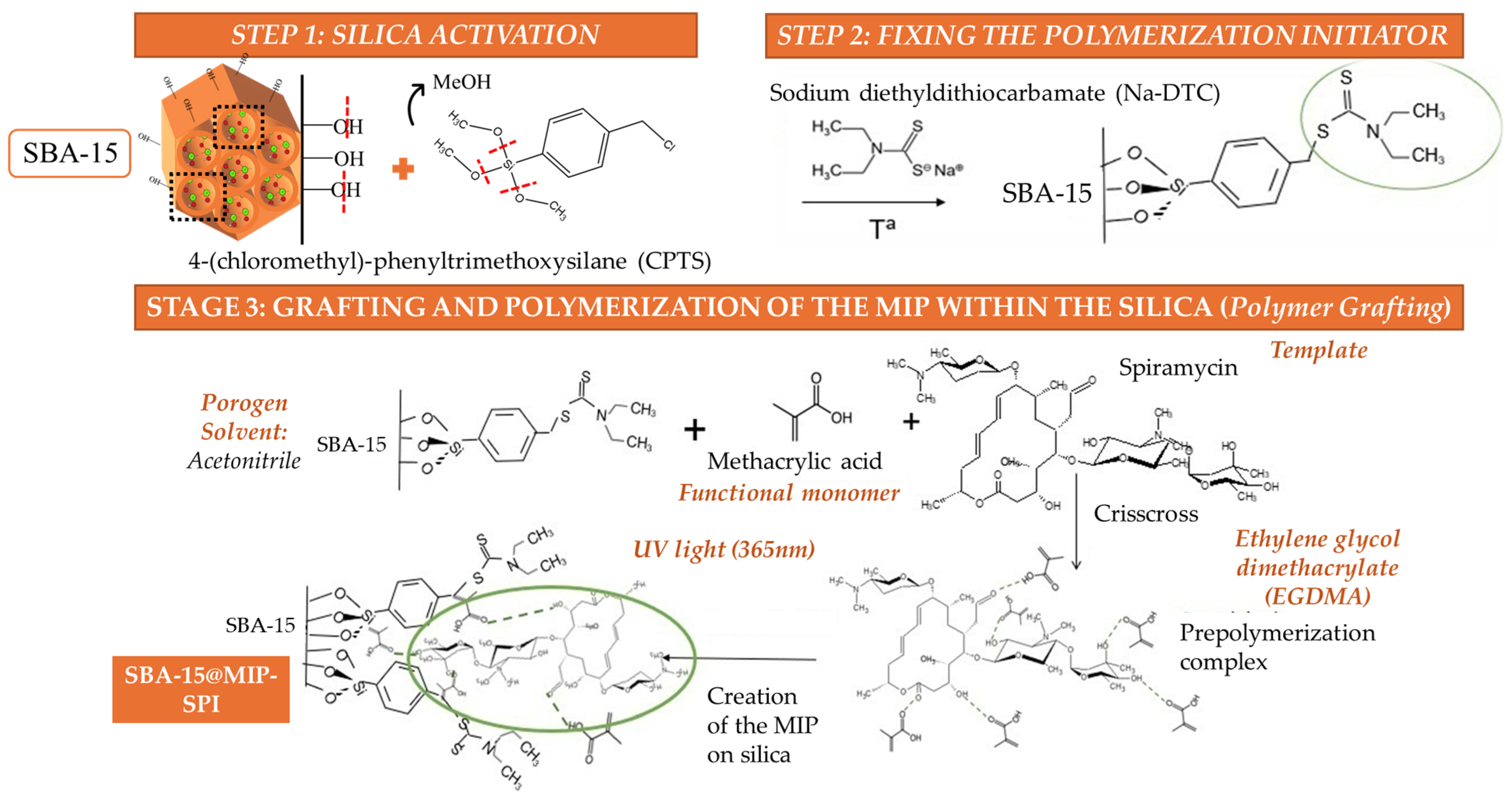
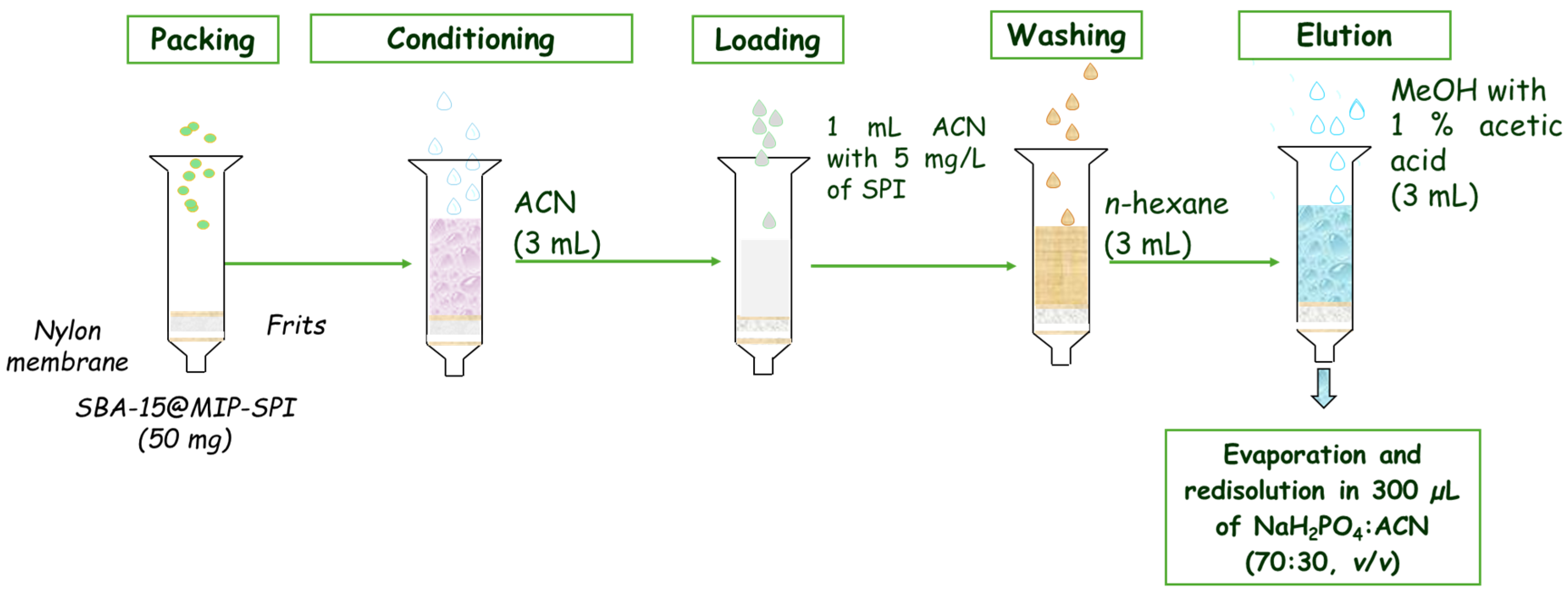
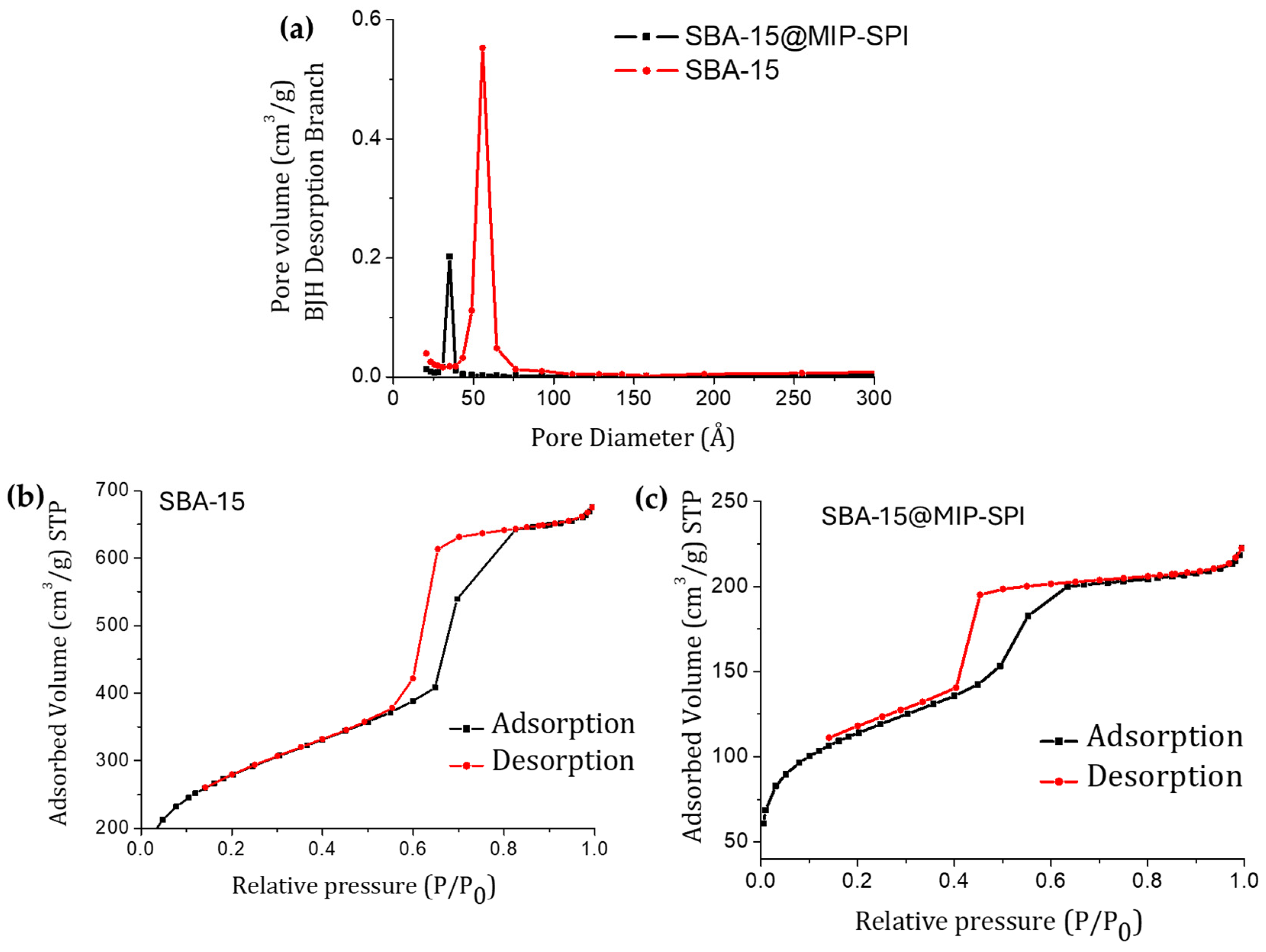
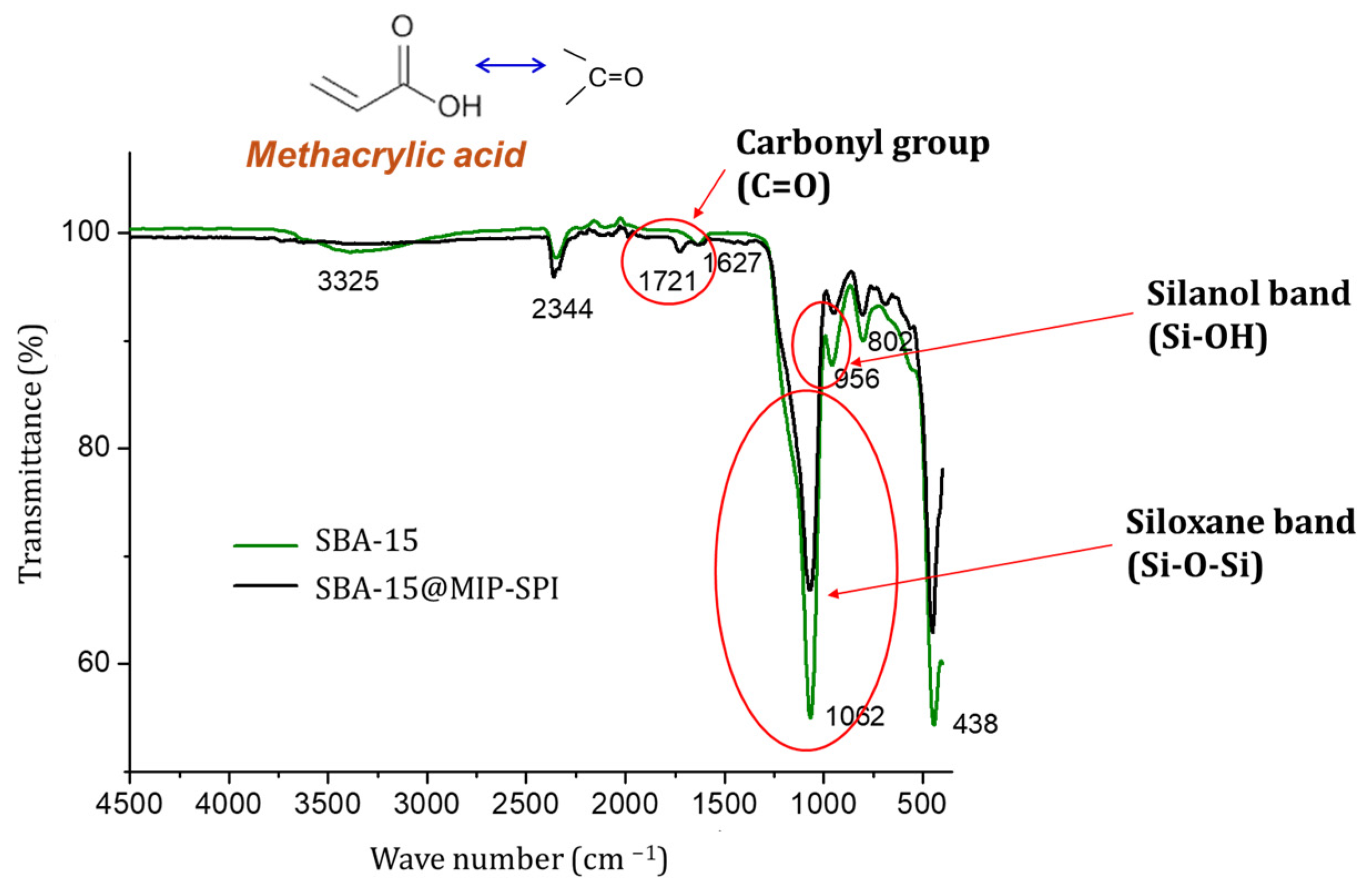
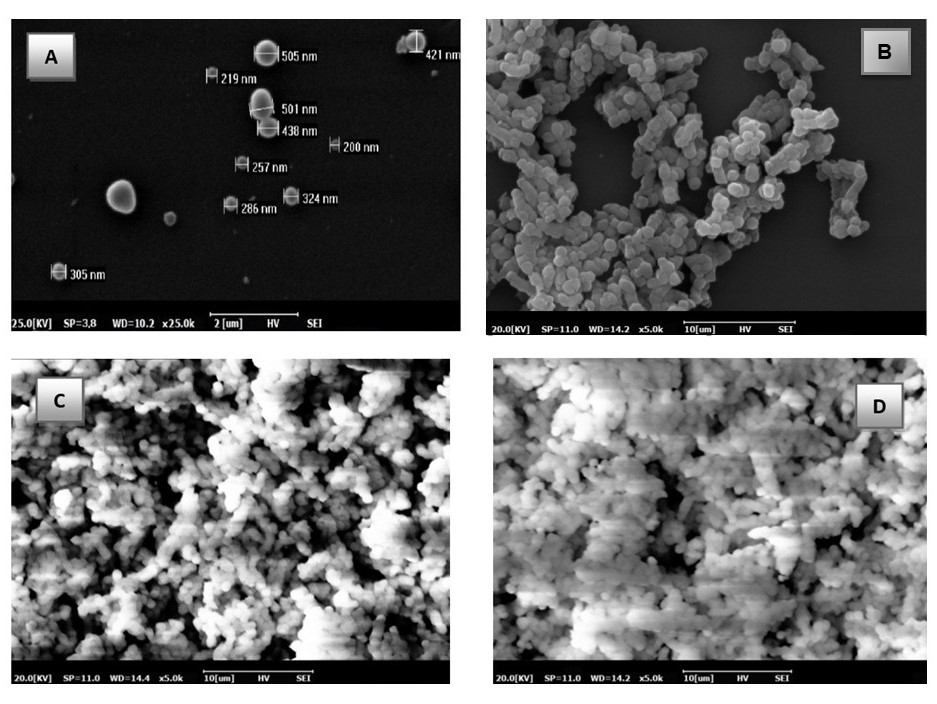

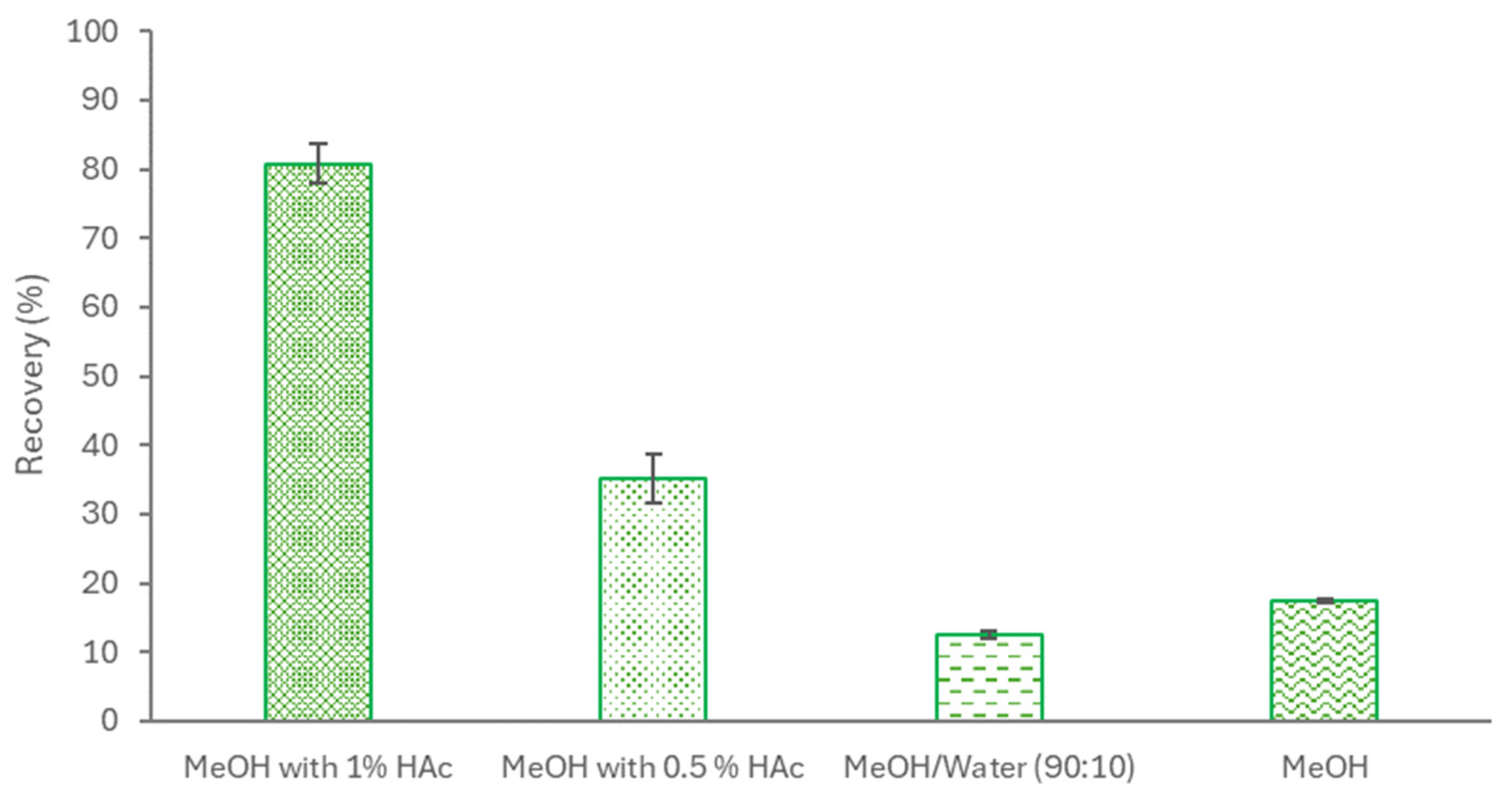
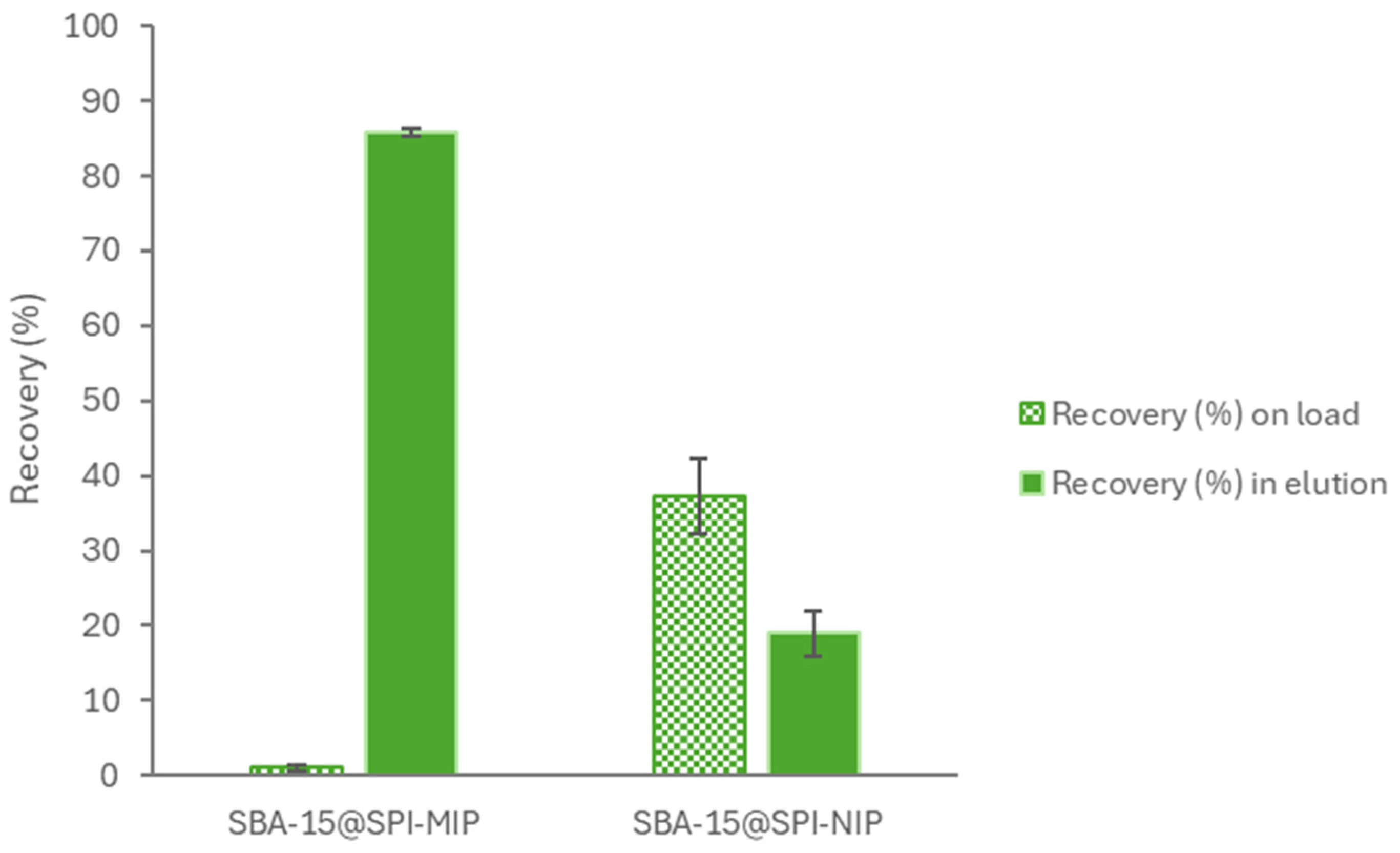
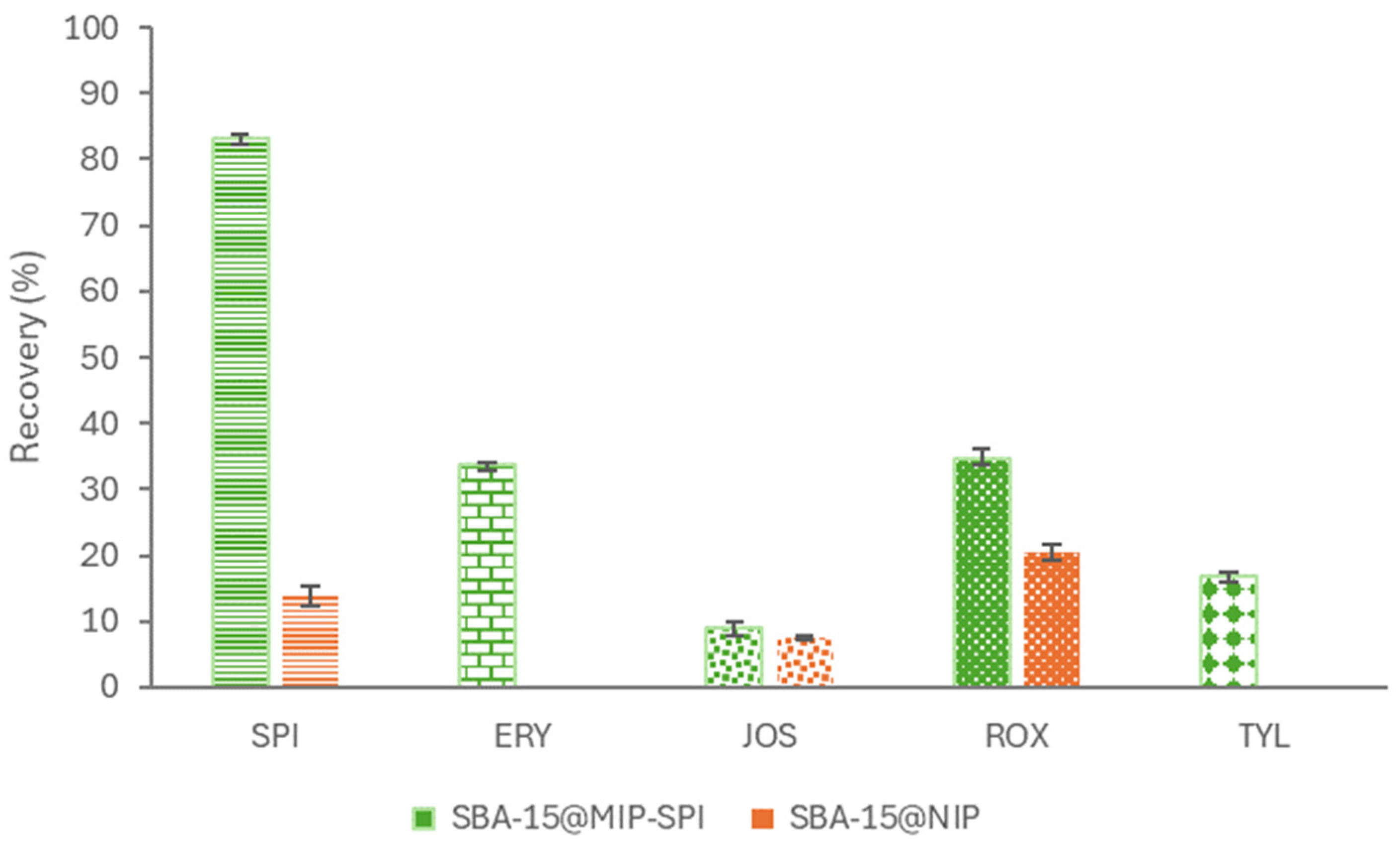
| Time (min) | % ACN | % Phosphate Buffer | Flow (mL/min) |
|---|---|---|---|
| 0 | 50 | 50 | 1.000 |
| 3 | 50 | 50 | 1.000 |
| 7 | 58 | 42 | 1.200 |
| 15 | 58 | 42 | 1.200 |
| 16 | 70 | 30 | 1.500 |
| 20 | 70 | 30 | 1.500 |
| Silica | SBET a (m2/g) | BJH Pore Diameter b (Å) | Pore Volume c (cm3/g) |
|---|---|---|---|
| SBA-15 | 998.5 | 56.0 | 1.02 |
| SBA-15@MIP-SPI | 404.9 | 35.1 | 0.33 |
| Linear Range (µg/mL) | Linearity R2 | LOD a MDL (µg/mL or µg/g) | LOQ b MQL (µg/mL or µg/g) | Accuracy n = 3 (Recovery ± SD %) | Intra-Day Precision n = 3, 1 day (RSD %) | Inter-Day Precision n = 3, 3 days (RSD %) |
|---|---|---|---|---|---|---|
| 0.1–15 | 25.15× + 0.84 0.999 | 0.01 0.008 | 0.04 0.028 | 81 ± 3 | 0.6 | 4.4 |
Disclaimer/Publisher’s Note: The statements, opinions and data contained in all publications are solely those of the individual author(s) and contributor(s) and not of MDPI and/or the editor(s). MDPI and/or the editor(s) disclaim responsibility for any injury to people or property resulting from any ideas, methods, instructions or products referred to in the content. |
© 2024 by the authors. Licensee MDPI, Basel, Switzerland. This article is an open access article distributed under the terms and conditions of the Creative Commons Attribution (CC BY) license (https://creativecommons.org/licenses/by/4.0/).
Share and Cite
González-Gómez, L.; Morante-Zarcero, S.; Pérez-Quintanilla, D.; González, G.P.; Garcinuño, R.M.; Hernando, P.F.; Sierra, I. Development and Characterization of SBA-15 Imprinted Polymers for Spiramycin Analysis. Separations 2024, 11, 247. https://doi.org/10.3390/separations11080247
González-Gómez L, Morante-Zarcero S, Pérez-Quintanilla D, González GP, Garcinuño RM, Hernando PF, Sierra I. Development and Characterization of SBA-15 Imprinted Polymers for Spiramycin Analysis. Separations. 2024; 11(8):247. https://doi.org/10.3390/separations11080247
Chicago/Turabian StyleGonzález-Gómez, Lorena, Sonia Morante-Zarcero, Damián Pérez-Quintanilla, Gema Paniagua González, Rosa M. Garcinuño, Pilar Fernández Hernando, and Isabel Sierra. 2024. "Development and Characterization of SBA-15 Imprinted Polymers for Spiramycin Analysis" Separations 11, no. 8: 247. https://doi.org/10.3390/separations11080247







